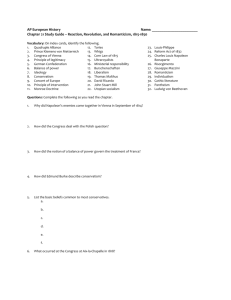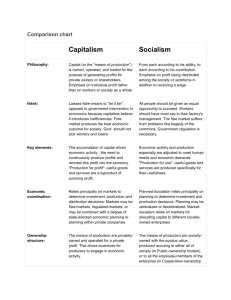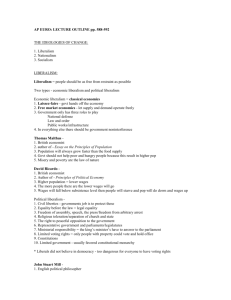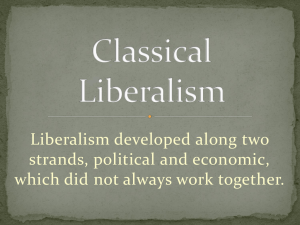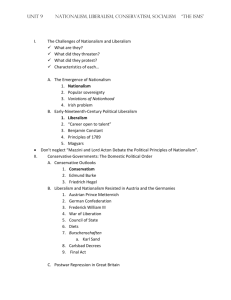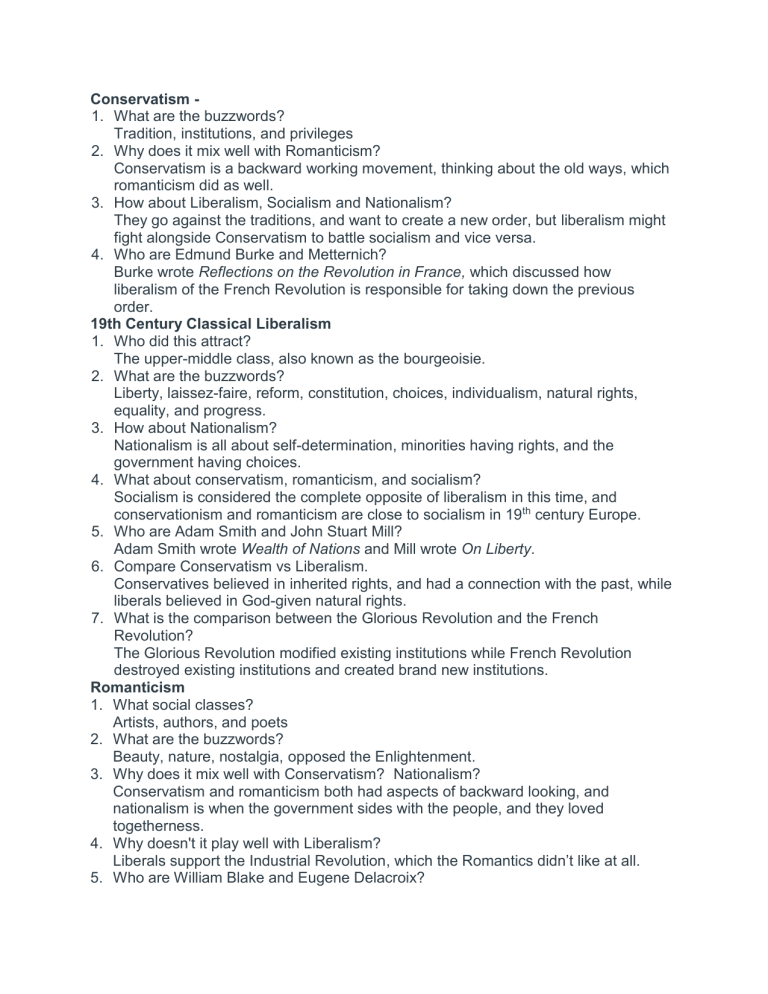
Conservatism 1. What are the buzzwords? Tradition, institutions, and privileges 2. Why does it mix well with Romanticism? Conservatism is a backward working movement, thinking about the old ways, which romanticism did as well. 3. How about Liberalism, Socialism and Nationalism? They go against the traditions, and want to create a new order, but liberalism might fight alongside Conservatism to battle socialism and vice versa. 4. Who are Edmund Burke and Metternich? Burke wrote Reflections on the Revolution in France, which discussed how liberalism of the French Revolution is responsible for taking down the previous order. 19th Century Classical Liberalism 1. Who did this attract? The upper-middle class, also known as the bourgeoisie. 2. What are the buzzwords? Liberty, laissez-faire, reform, constitution, choices, individualism, natural rights, equality, and progress. 3. How about Nationalism? Nationalism is all about self-determination, minorities having rights, and the government having choices. 4. What about conservatism, romanticism, and socialism? Socialism is considered the complete opposite of liberalism in this time, and conservationism and romanticism are close to socialism in 19th century Europe. 5. Who are Adam Smith and John Stuart Mill? Adam Smith wrote Wealth of Nations and Mill wrote On Liberty. 6. Compare Conservatism vs Liberalism. Conservatives believed in inherited rights, and had a connection with the past, while liberals believed in God-given natural rights. 7. What is the comparison between the Glorious Revolution and the French Revolution? The Glorious Revolution modified existing institutions while French Revolution destroyed existing institutions and created brand new institutions. Romanticism 1. What social classes? Artists, authors, and poets 2. What are the buzzwords? Beauty, nature, nostalgia, opposed the Enlightenment. 3. Why does it mix well with Conservatism? Nationalism? Conservatism and romanticism both had aspects of backward looking, and nationalism is when the government sides with the people, and they loved togetherness. 4. Why doesn't it play well with Liberalism? Liberals support the Industrial Revolution, which the Romantics didn’t like at all. 5. Who are William Blake and Eugene Delacroix? Delacroix wrote The Sorrows of Young Werther about dying for love and Blake wrote poetry about the “dark satanic mills”. 6. What about Frankenstein? Science gone wrong, which conflicts the Enlightenment. Nationalism 1. Social Classes? All nationality transcends class 2. What are the buzzwords? Group spirit, freedom, and independence. 3. Who does it mix well with and why? Nationalism mixes well with liberalism because they both share self-determination and they share beauty and ideals with romanticism. 4. What about the Conservatives? Nationalism destabilizes conservatism, with the quick changes which goes against the stability of tradition. 5. Who is Mazzini? Hegel? Mazzini wrote The Duties of Man which claimed that everyone has a duty to your God, your family, and your country 6. What is thesis and antithesis? He stated that Germany was so disunified (thesis) that eventually that Germany would become unified (antithesis). 7. What about Grimm's fairy tales? The Grimm Brothers were collecting people’s stories, that were the nation’s tales. 8. What is Liberty Leading the People? What is going on in this painting? A very famous painting that frames French nationalism and romanticism. Socialism 1. What social classes? Working classes 2. What are the buzzwords? Justice, equality, fairness, harmony, cooperation, association, organization, community, and freedom. 3. Who do they mix well with and why? Sometime romantic might use it, but it normally doesn’t fit with any other isms. 4. Who does not get along with Socialism? Conservatism and liberalism don’t go with socialism 5. Who is Louis Blanc? Karl Marx (why is he put in the socialism part and not communism?) Louis Blanc wrote believed in organizing work as a society. Marx wanted equality and justice for the people, not the way communism is now. Relationship between Conservatism, Liberalism and Socialism 1. What is conservatism based on? Society’s groups and their privileges within those groups. 2. What do liberals and socialists want to do with the system of privilege? They both wanted to abolish privilege. 3. What is liberalism saying about individualism? Liberalism wanted everyone to have equal rights and live through their own lives. 4. What do socialists say about individualism? Collectivism? They wanted to abolish group privilege and keeping everyone equal. 5. How are liberalism and socialism different? Liberalism is focused on individualism while, socialism is more about collectivism 6. What is money privilege? The more money someone has, the more opportunities they are to earn. 7. What is the thing about private property and socialism? Socialism believes in private property, while that property threatens both liberals and conservatives land. Feminism 1. What social classes? Women of all classes 2. What are the buzzwords? Taking away gender privilege, gender equality 3. What is gender privilege? What is gender equality? The privilege of being educated, voting, owning property, or filing a divorce could only be done by men. Gender equality is where everyone can live based on their natural rights, regardless of gender. 4. What does this ism mix well with and why? Liberalism and socialism because most women of those social classes believed in equality, mainly gender equality. 5. Who does it not play well with and why? Conservatism because women normally weren’t in the public’s eye. 6. Who are Mary Wollstonecraft and John Stuart Mill? Mary Wollstonecraft wrote A Vindication of the Rights of Woman, focusing on women’s rights and Mill wrote The Subjection of Women with the help of his wife.

